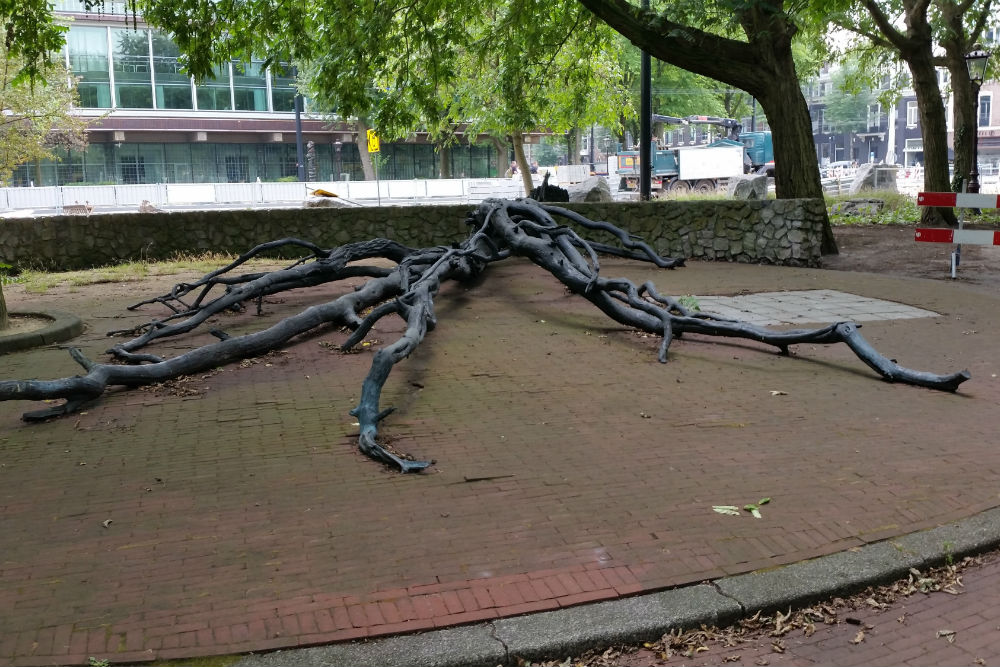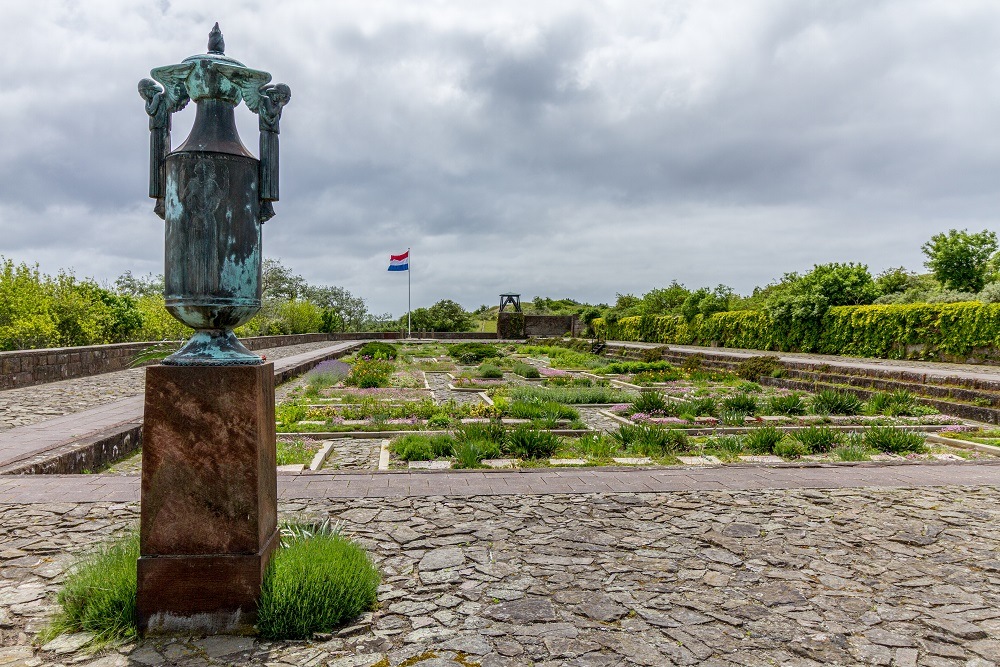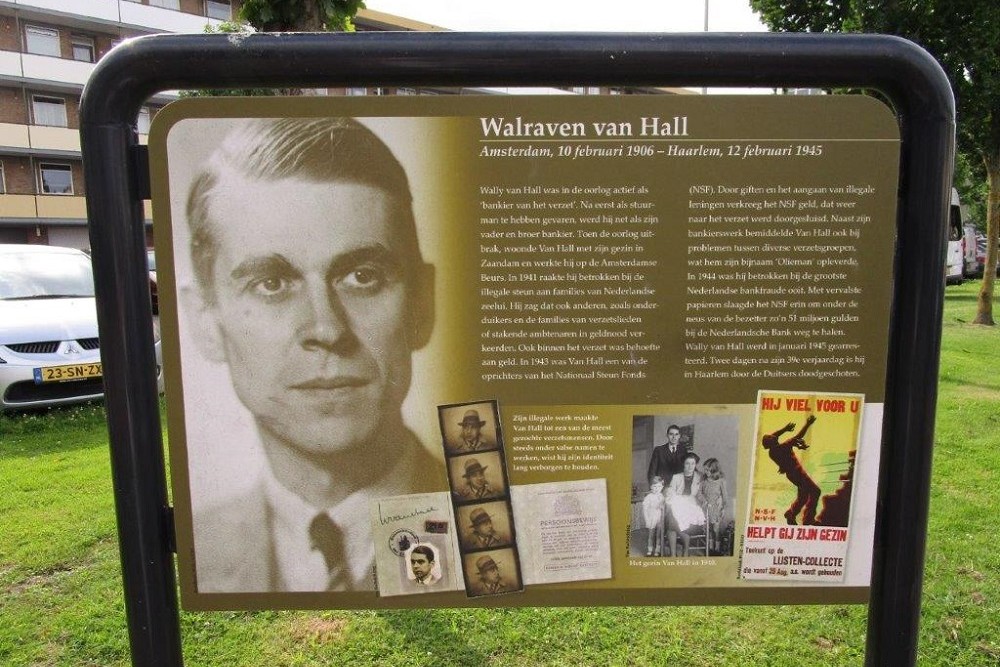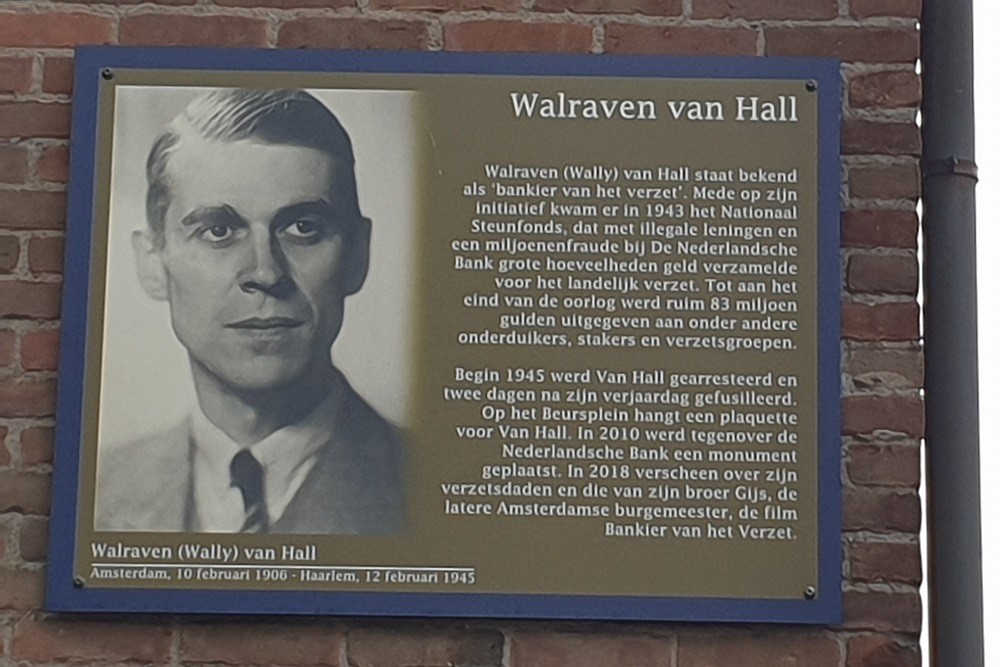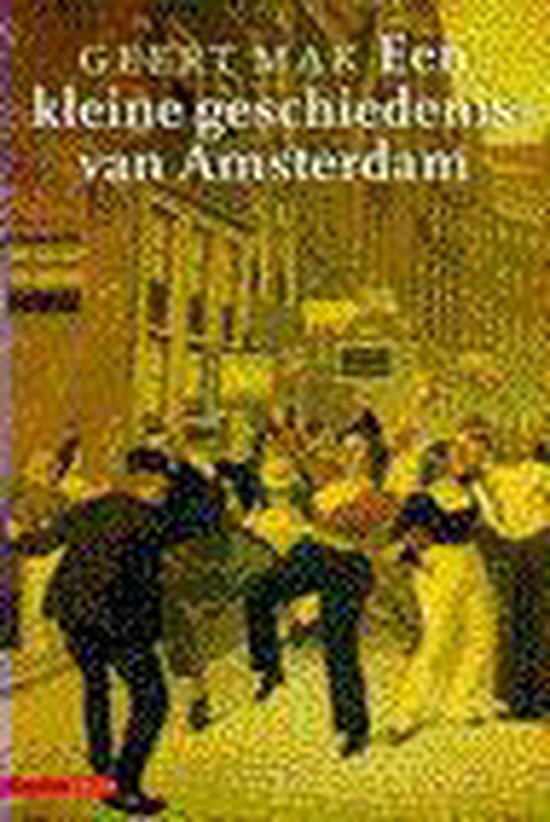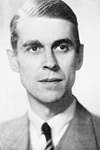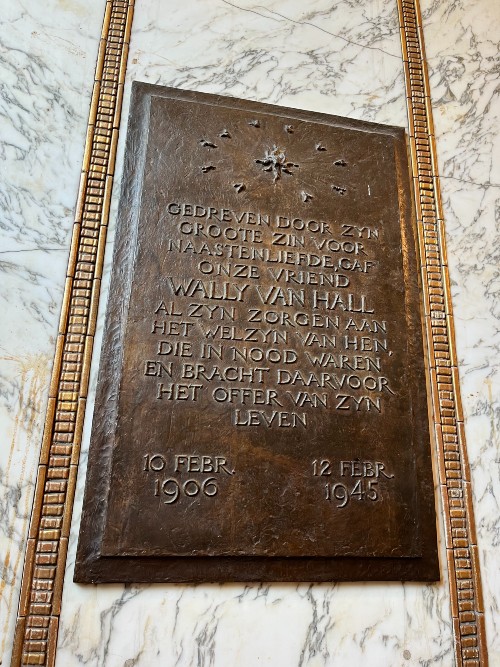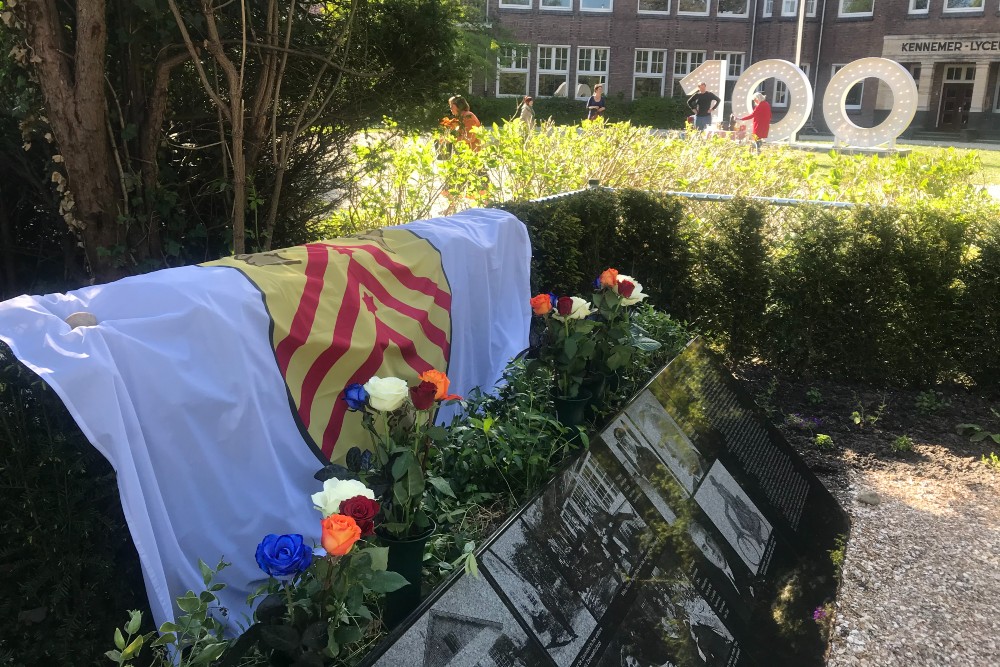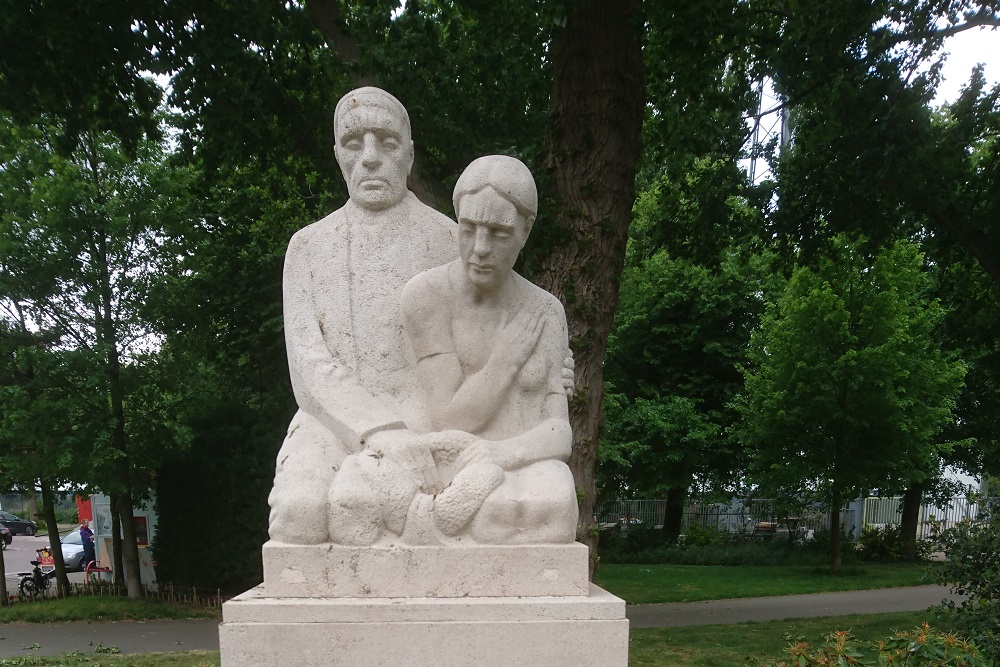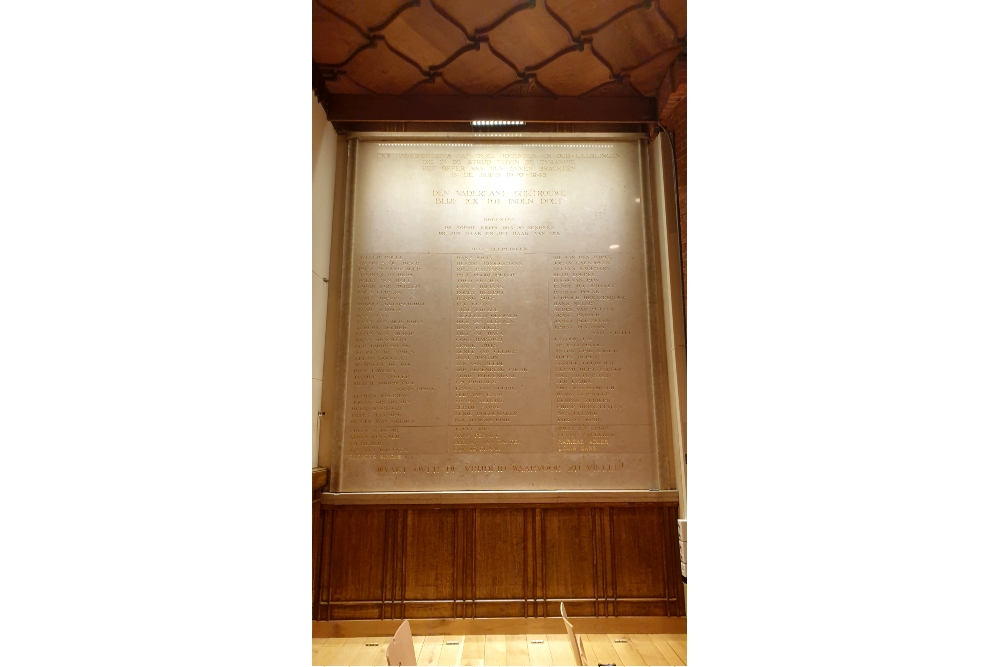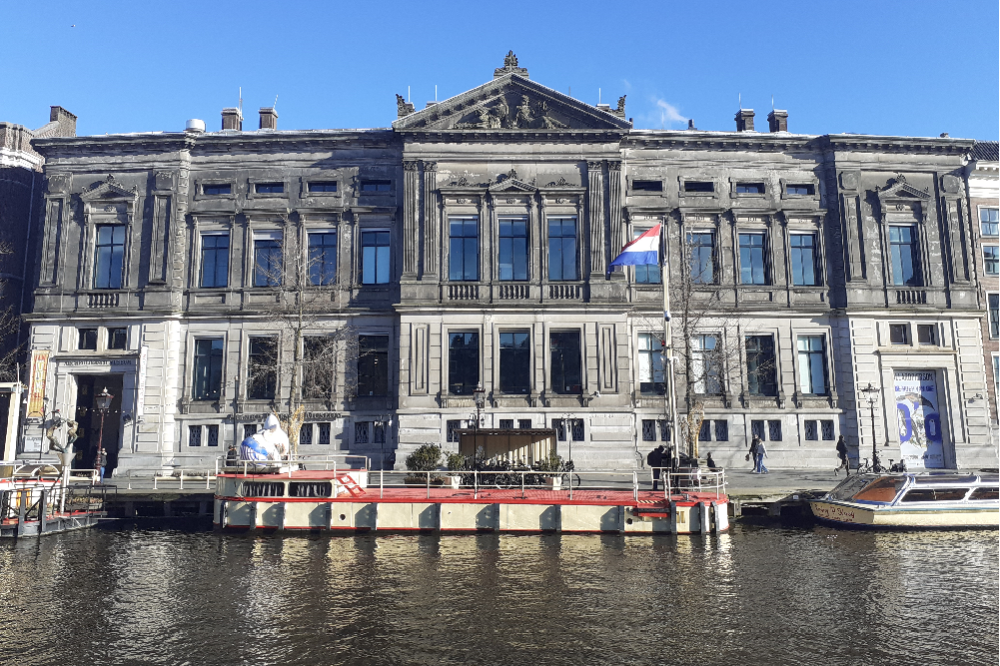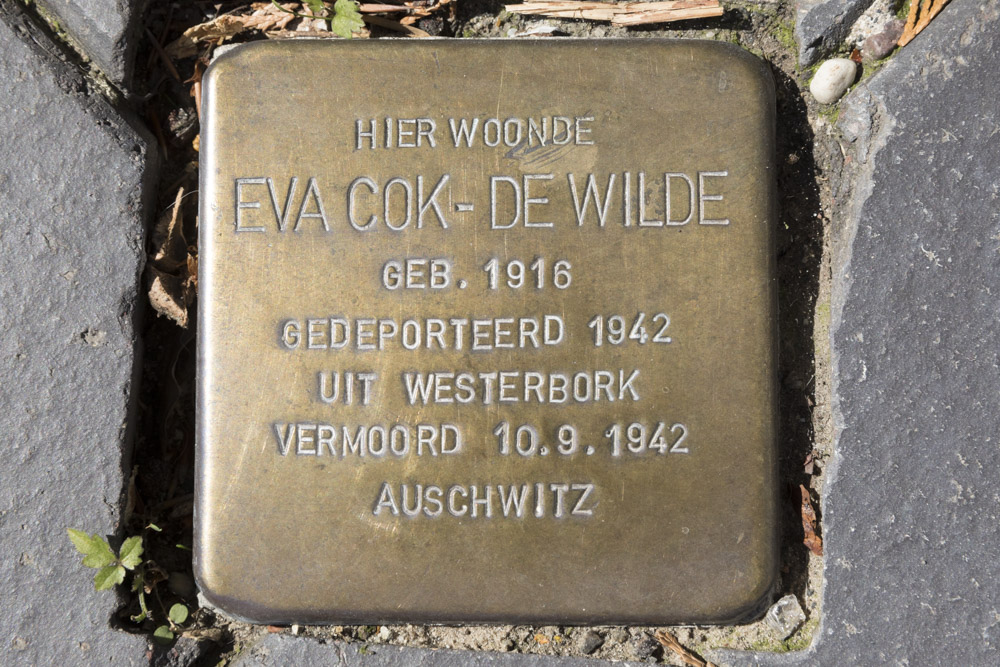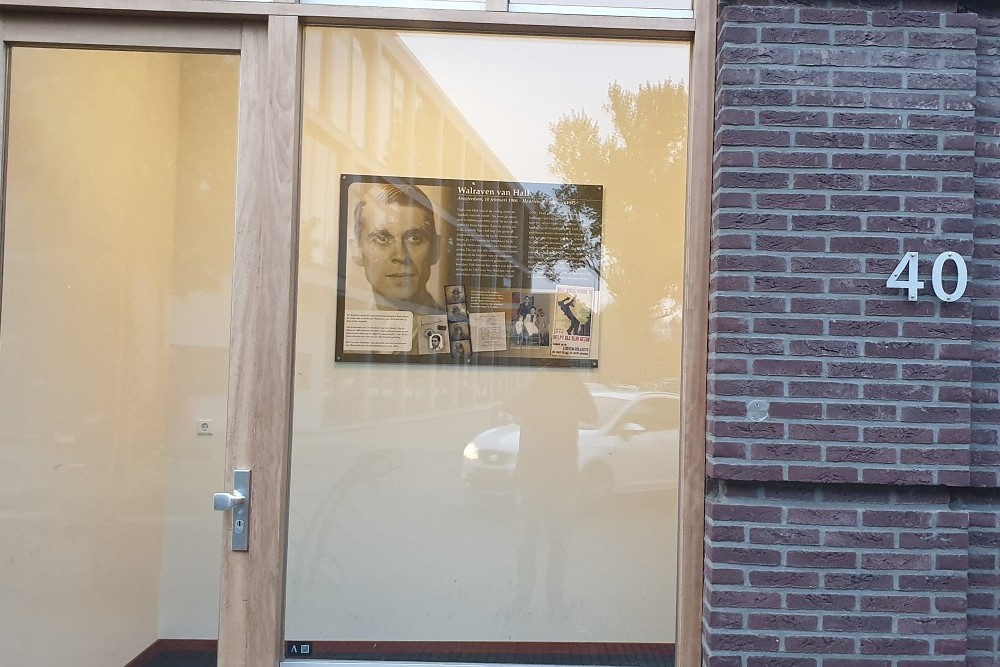Introduction
"Support is not a personal hobby, but an obligation"
(Walraven van Hall).
Walraven van Hall was one of the greatest of the Dutch resistance fighters during the Second World War. He was able to create a financial construction through inventiveness, quirkiness and help from others, with which he made a great contribution to Dutch illegality. The National Support Fund (NSF) he founded during the war was responsible for the financial care of thousands of people affected by the German occupation. The fund also supported numerous other resistance activities.
Apart from being "banker of the resistance", Walraven van Hall was also a capable negotiator. He succeeded in bringing a number of resistance organizations to cooperate more closely. This article will elaborate on this person, who was of great importance for the Dutch resistance and who had to pay for his illegal activities with the ultimate price.
Definitielijst
- resistance
- Resistance against the enemy. Often also with armed resources.
Images
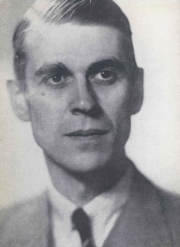 Walraven van Hall, Banker and Prime Minister of the resistance. Source: Biografisch Woordenboek van Nederland.
Walraven van Hall, Banker and Prime Minister of the resistance. Source: Biografisch Woordenboek van Nederland.Prewar years
Youth, education and seamanship
Walraven (Wally) was born on February 10, 1906 in Amsterdam. He was the sixth child of a total of ten children of the couple Adriaan Floris van Hall and Petronella Johanna Boissevain. His parents were both of well-to-do descent. A large part of the Van Hall’s patrician family worked in the stock exchange and banking sector, and a good many of the family were members of the Senate and mayors. The Boissevains were also a wealthy Amsterdam regent family. Walraven grew up in a liberal and a well-to-do environment. His parents were Dutch Reformed, but religion would not play a major role in his life.
Having enjoyed a private education during the first school years, he later attended the primary school on the Keizersgracht. Partly due to a long illness, he sustained a learning disadvantage. In spite of this he was capable of completing the primary school with good results. In 1919 he continued his school education on the Amsterdam Lyceum. In 1920, the Van Hall family moved to Bentveld, near Zandvoort. Because of this Walraven had to switch to the Kennemer Lyceum in Overveen. In July 1922 he obtained his diploma there.
Already, Walraven was an avid yachtsman and the sea had a great attraction for him. He chose for a career in the merchant navy. He studied at the Maritime Academy Willem Barentsz on the island of Terschelling and successfully graduated here in 1925. He joined the Royal Dutch Lloyd Ltd. as an apprentice mate. In 1928, after receiving the certificate for third mate and radiotelegraphy, he was appointed officer in the Merchant Navy.
During his seamanship Van Hall made trips to Germany and South-America. After he had obtained the diploma for second mate in 1929, he was physically disqualified in June of that year. His eyesight was found to be too bad to pursue a career in the merchant navy any longer.
Months in New York
Following his disqualification for further service with the Royal Dutch Lloyd, Wally van Hall moved to the United States. Here he hoped to find a situation with a resident shipping company. Exactly during those days (end 1929) the American stock exchange crashed and an economical crisis ensued. Due to this, Walraven failed to find any job in the shipping branch. The older brother of Walraven, the post war mayor of Amsterdam, Gijsbert (Gijs) van Hall (1904-1977), also stayed in New York at that moment. He was employed on Wall Street with the securities and investment firm Kean, Taylor & Co. Gijs succeeded in providing his younger brother Walraven with a job at a bank, also situated on Wall Street.
In New York Walraven experienced pleasant months. He enjoyed life in the metropolis. He had a lot of friends and often went out. But he was not content with certain matters, especially with his work. The job he held was below his abilities. He looked for other work, but partly because of the economical crisis, he did not succeed to find a better job.
In 1931 he returned to the Netherlands. The reason was to extend his visa (Pursuant to an American rule, this should be done in the country of origin). However, it would not come as far as that.
Banker at Zutphen and Zaandam
Walraven’s father was director of the Amsterdam bank H. Oyens & Sons in 1931. He offered his son the position of co-director of a branch office in the town of Zutphen. Walraven accepted this position and went to work there.
The work at H. Oyens & Sons and the life at Zutphen was to his liking. Soon he held board positions in various associations. Later on he would also be involved with the foundation of the Zutphen department of the Air Protection Service (LBD). People described him as a charismatic figure, who often was the pacesetter at parties.
In 1930 he met his future wife, Anna Mathilde (Tilly) den Tex 1907-1989), who, just like Walraven himself came from a wealthy patrician family. They married on March 1, 1932 and would have three children: Adrienne (Attie) (April 5, 1933), Adriaan Floris (July 28, 1936) and Mary-Ann (April 26, 1940).
On March 1, 1940 Walraven van Hall was appointed as a partner in the banking and securities office Wed. J. te Veltrup & Zoon in Zaandam. The family moved to the 42 Zaandamse Westzijde. In this new capacity Walraven also gained access to the Amsterdam Securities Trading Association (VvdE) and to the Amsterdam stock exchange.
Images
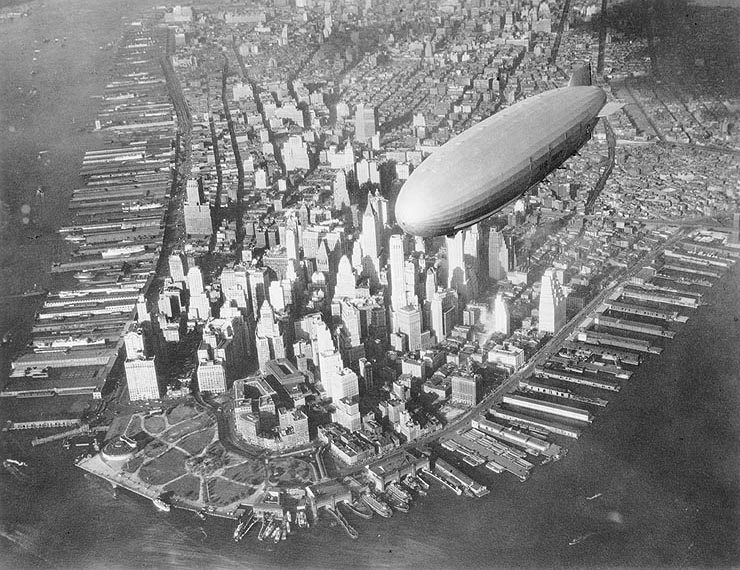 Manhattan (New York), beginning of the 30s. Walraven enjoyed pleasant months here. Source: U.S. Naval Historical Center Photograph.
Manhattan (New York), beginning of the 30s. Walraven enjoyed pleasant months here. Source: U.S. Naval Historical Center Photograph.Beginning of the war
German invasion and Dutch Union membership
On May 10, 1940 Nazi Germany invaded the Netherlands. The people of Zaandam were awakened at five o’clock in the morning by the sound of passing aircraft and anti-aircraft artillery. The outdated Dutch army was no match for the trained and well-equipped Wehrmacht. After the bombing of Rotterdam on May 14, 1940 the Netherlands surrendered and was occupied by the Germans.
In the months following, the Dutch tried to continue as good as possible with the life they led before the war. Many people did not know what attitude they had to adapt towards the German occupation. There were people who resisted, but this concerned only a few.
In the meantime the National socialist Movement (NSB) of Anton Mussert saw its chance. Before May 1940, this party had little prestige and power (at least less than it had hoped for). Now that the German occupation was a fact, it hoped to gain more power through an active collaboration with the Nazis. Many people, however, (Walraven included) hated the NSB passionately.
Nederlandse Unie
On July 24, 1940 the triumvirate Louis Einthoven (police commissioner of Rotterdam), Johannes Linthorst Homan (Queen’s Commissioner in Groningen) and Jan de Quay (a university of Tilburg professor and postwar prime minister) founded the ‘Nederlandse Unie’ (Netherlands Union). The goals of this movement were to break through pre-war polarization and to strengthen the national identity. The Nederlandse Unie accepted the occupation of the Netherlands as a fait accompli and therefore cooperated with the German occupiers. Many people considered this movement as a way to express their dissatisfaction with the NSB. The Netherlands Union would eventually number 600.000 members. Walraven van Hall was one of the first persons in Zaandam who registered.
When in November 1940 a local branch of the Unie was established in Zaandam, Van Hall was appointed chairman. Jacob (Jaap) Buijs, a Zaandam timber merchant, became secretary. The Zaandam branch received hundreds of applications. The maximum number of members would ultimately be 956.
The Nederlandse Unie was in a difficult situation. Officially, she accepted the German occupation, but many members disagreed with this position. The management of the Unie had to compromise between yielding to the Germans and taking their own course. This resulted in conflicts, among others how to deal with Unie membership of Jews and the compulsory participation of Unie members to Winter Aid collections. On December 14, 1941 the Germans were fed up with the machinations of the Nederlandse Unie and forbade the organization. Walraven van Hall, together with his fellow Unie member Buijs, decided to actively oppose the Germans.
Commencing resistance work
Already during his membership of the Unie, Walraven had begun with his resistance work. His first actions consisted of fundraising, which he held among his friends and acquaintances of the stock exchange. The fundraising collections served to support people who were affected by the February strike. The families of those, who were shot during this strike needed support for the lost incomes and there were many who were deprived of their income due to the strike layoffs. Walraven, his brother Gijs and a number of others decided to support these families financially. The collections took place on a small scale: they approached people with the question whether they were willing to donate for instance DFL 10.
Definitielijst
- collaboration
- Cooperation of the people with the occupying forces, more generally spoken the term for individuals who cooperate with the occupying force is collaborator.
- Jews
- Middle Eastern people with own religion that lived in Palestine. They distinguished themselves by their strong monotheism and the strict observance of the Law and tradition. During World War 2 the Jewish people were ruthlessly persecuted and annihilated by the German Nazis. . An estimated 6,000,000 Jews were exterminated.
- Nazi
- Abbreviation of a national socialist.
- NSB
- National Socialist Movement. Dutch political party sympathising with the Nazis.
- resistance
- Resistance against the enemy. Often also with armed resources.
- Wehrmacht
- German armed military forces, divided in ground forces, air force and navy.
Images
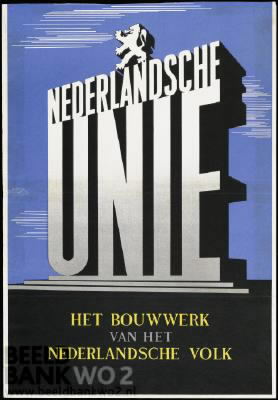 Propaganda poster of the Nederlandsche Unie. Walraven van Hall was chairman of the local department in Zaandam. Source: Beeldbank WO2.
Propaganda poster of the Nederlandsche Unie. Walraven van Hall was chairman of the local department in Zaandam. Source: Beeldbank WO2.Support to sailors and their families
Seamans pool
After the German invasion nearly all of the Dutch vessels that were at sea did not return to the occupied Netherlands. The Dutch crew members did not want to work for the Germans who had occupied the country. The crews aboard the ships, about 18.000 men now worked for the allies and the Dutch government in exile. When sailors are at sea, the shipping companies pay the families at home a compensation to be able to provide for their livelihood.
On April 11, 1941 the Germans announced that the shipping companies had to stop paying the wages to the sailors’ families. The Dutch government in London later that month indicated that it would guarantee loans for financial support to the sailors’ families. For that reason the shipping companies simply continued to pay the fees to the families of seafarers. During that month, however, the Germans announced that the fees had to be reduced as of October 1st. In the first instance only the families of seamen working in higher (officers) positions were affected. On February 1, 1942 however, the Germans announced a further reduction. Now, the "ordinary" crew members were also affected. Moreover, this reduction, except for the merchant navy, also applied to the families of navy personnel.
To enable the seafarers’ families to make ends meet, aid committees were founded in various towns. These groups collected funds for the financial support of the aforementioned families. Walraven van Hall and Jaap Buijs were involved in the Amsterdam committee.
At the beginning of 1942 the various committees came into contact with each other. They then decided to combine and coordinate their activities. They gave the resulting organization, thus coming into being the name "Zeemanspot" (Seamans pool). Walraven van Hall was elected to the board, partly due to his many connections in the financial world. He was mainly engaged in obtaining financial resources for the organization. In the first instance it remained with donations. Walraven called on friends and asked if they wanted to donate money for his support of sailors’ families. Van Hall realised that if he would be caught by the Germans, he would face a severe penalty. For that reason he used the pseudonym "Van Tuyl", to thwart being traced and to protect his family.
Discount Institute Seamen
During the war, the Zeemanspot supported 4.700 families of merchant navy personnel, 1.400 families of Navy personnel and 300 families of army personnel. This required hundreds of thousand of guilders which could no longer be obtained by gifts from "good" Dutch people. Walraven van Hall decided to embark on a new financing, construction, borrowing money.
Van Hall again approached again (mostly wealthy) people whether they would be willing to lend money to the so-called Discount Institute, the administration department of the Zeemanspot. For this effort he received assistance from friendly tax inspectors as a result of which he could determine how wealthy someone was and how much money he or she could lend to the Discount Institute.
Walraven was of the opinion that a sound administration had to be kept, to keep track of the amount someone had lent to the Discount Institute. The names could not be recorded of course. If the Germans would find the administration, the lenders would be in grave danger. Van Hall contrived the following solution for this. Every person who lent an amount of money to the Discount Institute received in return a worthless share (a lapsed bond, an old silver receipt or a share in a bankrupt company), which stated in code how much a person had loaned. For example (source: Erik Schaap): "Java Petroleum Maatschappij no. 492 100x", the number had to be multiplied by1000. This person was entitled to DFL 100.000 after the war.
All these shares were kept on a list. This happened at the office of Gijs van Hall. If the Germans would find this list, it would not be of any use for them, since they could not recover the owners of these worthless shares. The Dutch government in exile had given guarantees for paying back the loans after the war.
The other directors of de Zeemanspot, including Iman Jacob van den Bosch (1891-1944) and Abraham Filippo, did initially not agree with this system. They considered it too great a risk to put things on paper. But partly because it turned out that the system was a succes – in 1942 alone, Gijs en Walraven succeeded in obtaining DFL 500.000 – the others applied it also.
On March 13, 1943 the Germans declared all banknotes of DFL 500 and 1000 invalid. Until March 31, the public could exchange these notes for smaller denominations at the tax offices. The tax authorities were only allowed to pay smaller denominations if it could be proved that the money was obtained legally. The Discount Institute worked on a large scale with notes of DFL 500 and 1000. She could not redeem them because they had to account for their origin. This of course was going to be difficult for the Discount Institute. They had to find a different solution.
Both Gijs en Walraven went with 100 notes of DFL 1000 to institutions and individuals. They asked whether they were able to exchange that money for the Institute so that they could account for these amounts.
This exchange trick went exceptionally well and soon the Discount Institute got rid of its "surplus" paper money. The Van Hall’s decided, together with Filippo, to endeavour more. They asked friendly institutions and individuals whether they still possessed notes of DFL 500 and 1000 and if so, if they could borrow them for the Zeemanspot. With the help of other people and institutions, and a number of "good" tax inspectors, they succeeded in changing these notes into smaller denominations. This action was very successful and generated DFL 784.000 in the first two weeks. Eventually, this would result in obtaining DFL 5,4 million during the war.
Definitielijst
- invasion
- Armed incursion.
Nationaal Steunfonds
Foundation Nationaal Steunfonds
Walraven and Gijs van Hall said that besides sailor families, other people and organizations who were affected by the German measures were also entitled to support. The Zeemanspot and the Discount Institute were functioning well. There was even more money in cash than was paid out. Meanwhile, the brothers Van Hall noticed that apart from the sailors’ families, more persons were in need of support. The antisemitic measures of the Germans became increasingly strict and thousands of Jews decided to go into hiding. Also, members of the Dutch military were compelled to go into hiding to escape internment in German POW camps. Walraven en Gijs van Hall thought that it should be possible to give these people financial support also. In June 1943 the Van Hall’s established the Landrottenfonds (Landlubberfund). This name was changed later on in the somewhat friendlier sounding name Nationaal Steunfonds (National Support fund) NSF.
Additional financial resources were required to care for the thousands of (family members of) people in hiding. Walraven en Gijs van Hall decided to approach a number of bankmanagers in order to ask them whether their institution could lend money to the NSF. Ten of the twelve banks who were sounded were willing to cooperate. They all provided, in exchange for worthless shares, a loan of DFL 200.000 on behalf of the NSF. The Dutch government also gave a guarantee for the loans taken out for the NSF that they would be refunded after the war.
Organization
Walraven van Hall en Iman Jacob van den Bosch set the NSF in motion. They travelled through the entire country and formed local committees. They also ensured that local (resistance) organizations joined the fund.
The NSF consisted of five departments, namely: collecting department, investigation department, payroll department, research department and administration. An application for support was made by completing a "Claims accident insurance form". These forms were collected by the district head (the NSF had divided the country into 23 districts) and then brought to Amsterdam where the applications were assessed.
Soon it became clear that it was impossible for the entire NSF to be led by a single person. Therefore, it was decided to divide the responsibilities among the various provinces. Van den Bosch occupied himself with the north and east of the country. Whereas Walraven led in North- and South-Holland, Zeeland and Utrecht. The management of the provinces of North-Brabant and Limburg was initially in the hands of A. Voorwinde. When he was arrested in August 1943 the leadership was taken over by Adreas Gelderblom. The three leaders of the NSF met once every two weeks to consult. Jaap Buijs was also often present, he was a confidant of Walraven and assisted him in his resistance work.
The triumvirate (Van Hall, Van den Bosch en Voorhoeve/Gelderblom) decided on whether or not to grant a benefit and distributed the money. The money was brought to the district heads by couriers. They passed it on to a number of local heads and these people on their turn passed it on to the people who payed out. By this construction each member of the NSF knew only a few other members. If one person was arrested, he could not possibly betray the entire organization.
Walraven had a daily meeting with his personal assistant/courier Van den Brink or ‘Brinkie’ (pseudonym for lieutenant Weeda of the Royal Dutch Navy) and Jaap Buijs. During these meetings requests for support were assessed and activities of the NSF in the western provinces of the Netherlands coordinated.
In mid-1943 the NSF-trade association ‘J’ was founded. This was a department of the NSF that was going to deal with the financial support of Jewish people in hiding. Great risks were connected with the supporting of Jews, so the organization was partly disconnected from the NSF and had its own board. Should the organization be discovered, then it would not have to be at the expense of the rest of the National Support Fund.
Definitielijst
- Jews
- Middle Eastern people with own religion that lived in Palestine. They distinguished themselves by their strong monotheism and the strict observance of the Law and tradition. During World War 2 the Jewish people were ruthlessly persecuted and annihilated by the German Nazis. . An estimated 6,000,000 Jews were exterminated.
- mid
- Military intelligence service.
- POW
- Prisoner of War.
- resistance
- Resistance against the enemy. Often also with armed resources.
Images
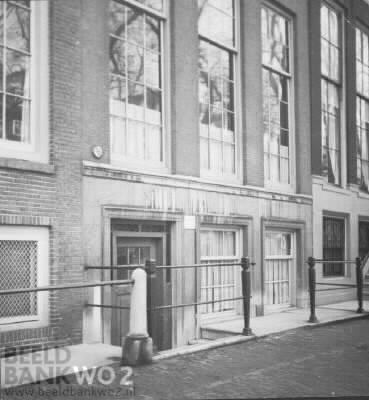 Leidschegracht 5. The operating base of Walraven van Hall and the ‘Nationaal Steunfonds’. Source: Beeldbank WO2.
Leidschegracht 5. The operating base of Walraven van Hall and the ‘Nationaal Steunfonds’. Source: Beeldbank WO2.Other resistance activities
The greaser
Walraven van Hall had been connected in 1943 with the founding of the National Committee of Resistance (NC). This organization had arisen from the student revolt and had the goal of coordinating and merging the Dutch illegality. In this objective the NC did not succeed, so it became a ‘normal’ resistance organization, which among other things would engage in espionage. Walraven remained closely involved with this resistance group throughout the war.
A great wish of the Dutch government in London and also of Walraven van Hall was that there would be better coordination and cooperation within the Dutch resistance. There was hardly any question of this. Pre-war polarization played a major role in this, for example, strict believers did not want to cooperate with the Communists and vice versa. Moreover, the organizations did not want to be overrun, because that would be at the expense of their own freedom of action.
Walraven van Hall however, was a good negotiator. He possessed great powers of persuasion, could bring problems into perspective and thus was able to bring people closer together. This earned him the nickname "de Olieman" (the greaser), someone capable of bringing smoothness into difficult negotiations. Walraven and a number other persons succeeded to bring the Landelijke Organisatie voor Hulp aan Onderduikers (National Organisation for Assistance to People in Hiding) into the NSF to better cooperation. During the first years these two organizations often operated on different paths.
Together with Lambertus Neher (the director of the PTT (GPO), fired by the Germans and representative of the Nationaal Comité van Verzet (National Committee of Resistance) and Hendrik Dienske (LO) Walraven founded the "kern": a periodical consult between the leaders of the most important Dutch resistance organizations, among others the LO, the NSF, the Personal Identity Centre (PCB), the National strong-arm squads (LKP). This created somewhat more coordination and collaboration within the resistance.
In October 1944 Walraven was also involved with the founding of the 1940-1945 Foundation, initially called Stichting 1940-1944 because it was expected that the war would soon be over. This was a collaboration between twenty resistance organizations, whose purpose was to (financially) support (family of) people who had participated in the illegality. Jaap Buijs became one of the leading figures within the foundation. Van Hall played an important supporting role in the background.
"Ordinary" resistance work by Walraven
Walraven van Hall had no problem in dealing with "ordinary" resistance work outside of his busy work for the NSF. For example, he supplied explosives to the armed resistance. He obtained the explosives through an acquaintance who was the security chief at the Zaandamse Artillerie Inrichtingen.
He also occupied himself with hiding shot down allied pilots. After the war, Weeda said about Van Hall: "Moving his own person completely aside, he was always prepared to do very dangerous work himself. It was always: "Brinkie, tomorrow I’ve got dangerous fireworks again. Don’t you think it’s better that I do it myself?"
Foundation of the Binnenlandse Strijdkrachten (Interior Forces)
In 1944 the armed Dutch resistance was divided into three groups. The progressive Council of Resistance (RVV), the confessional National strong-arm squads (LKP) and the Ordedienst (Orderservice) (OD), mainly consisting of former military personnel. These organisations had different views and motives. There were many mutual tensions between these groups.
The Dutch government in London aimed at a united armed resistance and for that reason established on September 5, 1944 the Binnenlandse Strijdkrachten (BS) (Interior Forces) with the aim to unite the three resistance groups. Walraven van Hall succeeded by his qualities as "greaser" to integrate the resistance groups and to persuade them to relinquish part of their power to Delta-Centre (Delta C), the name for the management of the BS. He yielded also people and office space of the NSF to the BS.
Thanks to Walraven the BS was able to grow into a fairly successful organization. Despite having no military background, Van Hall remained involved in the leadership of the Internal Forces. For example, he regularly gave advice to Henri Koot (commander in Chief of the BS), including the improvement of the logistics and the security of the organisation.
On September 17, 1944 the operation Market Garden began. By means of large-scale air landings at Arnhem, Nijmegen and Eindhoven the allies hoped to establish a bridgehead, from which the German Ruhr area could be conquered. If this operation would be successful, the war would soon have ended according to the allies. In order to prevent the transport of German troops and equipment, the Dutch government announced on the same day (September 17, 1944) a general strike by the Railway personnel. The more than 30.000 railway employees responded to the strike call: They laid down the work en mass and went into hiding. Striking was punishable by death.
The NS-management had taken this railway strike into account. They had arranged so-called ‘invasion funds’ to pay out the striking railway employees, their salaries during the first weeks following the announcement of the strike. However, operation Market Garden failed. The south of the country was liberated, but the northern part, beyond the great rivers remained in German hands. By the onset of the winter, it became clear that the war would take many months yet. The order to strike was not withdrawn.
The NS-board
The NS-board could not afford to pay their employees complete wages for a long period. Therefore the assistance of the NSF was necessary and the NSF was prepared to give it. However, there were conflicts between the NSF and the railways. The president of the NS considered the illegality as a group of adventurers who took too many risks. He also felt that the NS should retain responsibility for the payments of wages. The NSF was only allowed to finance. Moreover, the management wanted no money to be paid to Communists. The NSF did not agree with this construction.
Only at the beginning of 1945 a compromise was reached. The NSF would pay the wages of the NS-employees. Among others the LO would care of the distribution. The personnel council would be involved as much as possible into the work. Tensions would remain, however. In Amsterdam, for example, there were conflicts between Van Hall and the personnel council, which mainly arose because the personnel council had no knowledge of illegal work at all.
Definitielijst
- Binnenlandse Strijdkrachten (BS)
- Domestic Forces. Active resistance in the Netherlands under command of Prince Bernhard. The BS was established on 5 September 1944 and consisted of the three major resistance organisations, i.e. OD, LKP and RVV.
- collaboration
- Cooperation of the people with the occupying forces, more generally spoken the term for individuals who cooperate with the occupying force is collaborator.
- Railway strike
- This was announced on the radio and complied with by the Dutch railway staff on 17 September 1944. The railway strike was intended to support the allied plan Operation Market Garden. After the allied airborne landings had failed, Dutch railway staff remained on strike until the liberation.
- Resistance
- Resistance against the enemy. Often also with armed resources.
Images
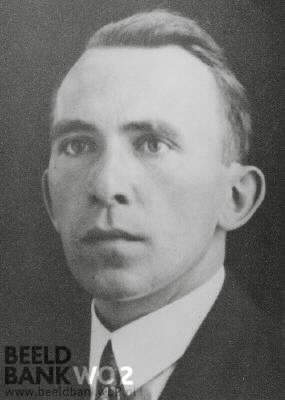 Henk Dienske of the LO founded together with Walraven van Hall and Lambertus Neher (National Committee) ‘de Kern’ for periodical consultations between opposition leaders. Source: Beeldbank WO2.
Henk Dienske of the LO founded together with Walraven van Hall and Lambertus Neher (National Committee) ‘de Kern’ for periodical consultations between opposition leaders. Source: Beeldbank WO2.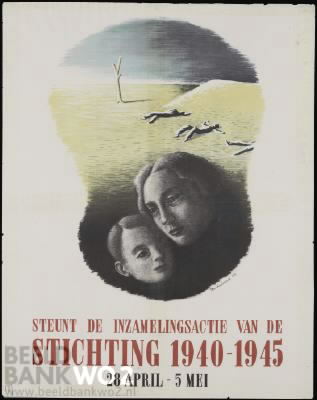 Poster from 1946 of the ‘940-1945 Foundation’, co-founded by Walraven van Hall. Source: Beeldbank WO2.
Poster from 1946 of the ‘940-1945 Foundation’, co-founded by Walraven van Hall. Source: Beeldbank WO2.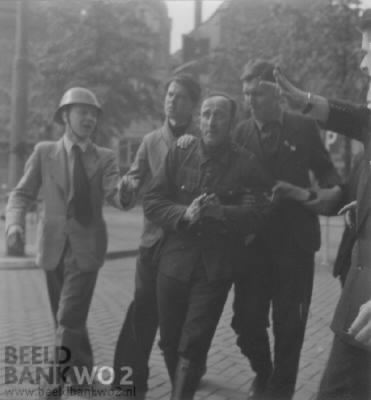 A German is arrested by members of the ‘Binnenlandse Strijdkrachten’ after the liberation. Walraven van Hall played an important role in bringing the various resistance groups together in the BS. Source: Beeldbank WO2.
A German is arrested by members of the ‘Binnenlandse Strijdkrachten’ after the liberation. Walraven van Hall played an important role in bringing the various resistance groups together in the BS. Source: Beeldbank WO2.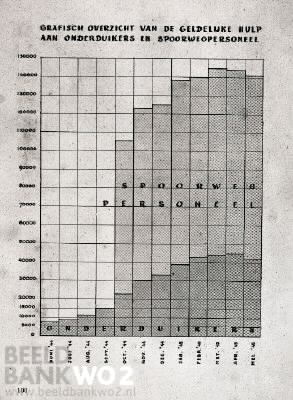 Graph of financial assistance to hiding railroad strikers, disbursed by the National Support Fund. Source: Beeldbank WO2.
Graph of financial assistance to hiding railroad strikers, disbursed by the National Support Fund. Source: Beeldbank WO2.Prime Minister of the resistance
The biggest bank fraud ever
Since 1944 the NSF had grown stronger. From then on, the organization was not merely concerned with paying money to (relatives of) people in hiding and seafarers, but also supported resistance groups such as the illegal press, espionage- and sabotage groups and numerous illegal groups. The financing structure of the NSF that had been used until then did not suffice any longer from September 1944 on. So other possibilities had to be found.
Walraven and Gijs van Hall again approached eight banks with the question whether they could help them. Eventually the following plan ensued. The banks pretended that they wanted to increase their cash reserves and asked Dfl 500.000 per month from the Central Bank of the Netherlands. They introduced various reasons for this. The management of the Twentse Bank, for example, suggested that a bomb might fall on the Central Bank of the Netherlands which consequently would block the safe. It would therefore be safer if the Twentse Bank had a larger cash reserve. This money, however, went directly to the NSF in exchange for invalid securities.
This bank arrangement earned the NSF eight million. But two months later, the Germans and the NSB-director of the Bank of the Netherlands (Meinout Rost van Tonningen) thought it very strange that in an area where the economy was running very slow, the banks continued to increase their cash reserves. For that reason, the Bank of the Netherlands refused to cooperate any longer in increasing the reserves.
The NSF, however, needed money. For the railway strikers alone, more than 5 million a month was required. Gijs van Hall came up with a solution. He remembered a large-scale bank fraud from the 1930s, in which the Swede Ivar Kreuger had seized millions of dollars by means of counterfeit treasury bonds (short-term government loans). "Why shouldn’t that work in the Netherlands also?", he thought.
The Van Hall’s were aware that they could not bring counterfeit treasury bonds in the market. The risk of exposure was too big and when the securities would remain in circulation after the war, this would be very detrimental fort he Dutch economy.
The Central Bank of the Netherlands had many treasury bonds lying in its safe. Walraven en Gijs decided to change the real papers for counterfeit copies. The real treasury bonds could then be converted to cash. The forgery of the treasury bonds however, was an extremely difficult task. The paper on which they were printed, contained hairs in different colours and was not freely available. The Personal Identity Office however, succeeded with the help of friendly printing companies and through the work of the forger Ab Oeldrich to produce well-matched imitations.
Gijs van Hall managed to acquire the cooperation of the Cashier Treasurer of the Central Bank of the Netherlands, Cornelis Ritter. Ritter personally went to the safe fifteen times to exchange the real treasury bonds for counterfeit copies. These treasury bonds were then exchanged for treasury papers from the Kas-Association (an Amsterdam bank). The promissory notes from this bank were freely negotiable. This did not apply to the securities of the Dutch Central Bank.
The last step was the exchange of the treasury notes for cash. This was also not simply possible. From September 5, 1944 on it was decreed that a person or an organisation was not allowed to withdraw more than DFL 100 a week from a bank account. Only when paying out salaries and the like could this rule be deviated from. For this also, a solution was found.
Walraven and Gijs van Hall knew Frans den Hollander (the former director of the Zaandam Artillery Inrichtingen). This person was in charge of a fund that was engaged in the payment of redundancy pay to staff of factories that could no longer operate because of the war. Thanks to his help, it was possible to make a construction, allowing the NSF to redeem the promissory notes at a number of banks. It seemed as if the money was meant fort he payment of redundancy pay. In reality, however, the money benefited the National Support Fund.
This biggest banking fraud in Dutch history furnished the NSF with DFL 51 million. This was amply sufficient to continue with the support of individuals and organization for the remaining period of the war.
The last months
In October 1944 Iman Jacob van den Bosch was arrested by the Germans. When they discovered his true identity, he was placed on a death list. On October 28, 1944 he was executed in the camp Westerbork. Since Andreas Gelderblom was in the liberated south, the leadership of the NSF came entirely in the hands of Gijs and in particular in those of Walraven van Hall.
Walraven van Hall became the "Prime Minister" of the resistance. The NSF supported numerous resistance activities: from the artists’ resistance and the illegal press to the armed resistance. Walraven van Hall also became a member of the National Work Committee, an organization with the purpose that aimed to sabotage the Liese-Aktion. The Liese-Aktion was a German measure aimed at recruiting Dutch men for the German "Arbeitseinsatz (labour deployment in Germany). The National Work Committee (LWC) would later on become the successor of the Kern (Core).
The work exhausted Walraven. He was occupied day and night with his illegal work and he constantly changed his hiding place to avoid arrest. But he continued to keep an eye on his fellow men and surroundings. His friend Jaap Buijs declared: "Many times I observed how he himself deadly tired arrived on a discussion and previously complained to me that he hardly could cope with the work and then, when he met his mates who were depressed either because comrades were arrested or executed or the work did not go as it should, with never failing energy helping them over the dead spot and encouraging them to carry on.
Due to the Railway strike and the harsh winter of 1944-1945 the food- and fuel distribution in occupied Netherlands came to an almost complete standstill. In his position as an illegal worker, Van Hall had the opportunity to obtain more food for himself. But in spite of his health deteriorating, he refused to exploit his high position in the resistance to enrich himself.
On the basis of the statement of the daughter of Walraven (Attie van Hall), Geert Mak described the last time she saw her father as follows:
"He rarely ever came home during those last months, that had become too dangerous". He had a rough journey behind him, on a bicycle with wooden tires from Amsterdam to Zaandam, and he was exhausted. His wife tried to warm him up and to give him some food. Eventually she climbed on a chair and from the back of the kitchen cupboard she took the last two sugar cubes, carefully preserved for the most extreme emergency. And he was allowed to have them". (Source Geert Mak).
Definitielijst
- Arbeitseinsatz
- “Labour deployment”. Forced deployment in the German industry. Approximately 11 million European citizens were rounded up and deployed into forced labour in the Third Reich. Not to be confused with the Arbeidsdienst or labour service, an organisation for national-socialist education for Dutch youngsters.
- NSB
- National Socialist Movement. Dutch political party sympathising with the Nazis.
- Railway strike
- This was announced on the radio and complied with by the Dutch railway staff on 17 September 1944. The railway strike was intended to support the allied plan Operation Market Garden. After the allied airborne landings had failed, Dutch railway staff remained on strike until the liberation.
- resistance
- Resistance against the enemy. Often also with armed resources.
Images
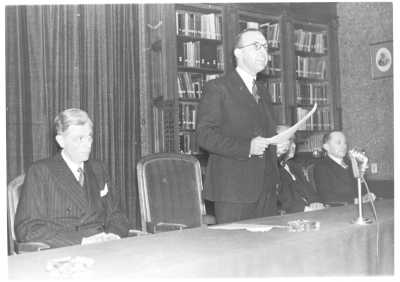 In his capacity as president of ‘De Nederlandsche Bank’, Meinoud Rost van Tonningen speaks. Source: Beeldbank WO2.
In his capacity as president of ‘De Nederlandsche Bank’, Meinoud Rost van Tonningen speaks. Source: Beeldbank WO2.The end
Betrayal and arrest
On January 27, 1945 Walraven van Hall was arrested at the Leidsegracht in Amsterdam by the Germans. Partly due to betrayal he fell into the hands of the Sicherheitsdienst (SD). Johan van Lom (pseudonym in illegality: Van Arkel) was a young lawyer who participated in the resistance. He was a member, among other things, of the Stichting 1940-1945. In September 1944, his girlfriend, who was a courier for ‘Het Parool’ (resistance newspaper), was arrested by the Landwacht. To get her free, Van Lom offered his services to the SD. He betrayed the moment and location of a number of meetings.
On January 12, 1945 Jaap Buijs was arrested due to his intervention. On January 26, again due to the betrayal of Van Lom, Teus van Vliet (a prominent member of the LO) was arrested by the Germans. Van Vliet told the SD that the following day a meeting of the National Work Committee would take place. He thought that he could reveal this information without consequences. He assumed that the resistance would be aware of this arrest and that the meeting would be cancelled.
This, however, did not happen. Despite some warnings that Van Vliet had been arrested, the meeting of the LWC was to take place as scheduled. When the members of the LWC arrived at the specified meeting address, they were awaited by the Germans. Walraven van Hall together with some other leading figures in the resistance were arrested (including the reverend Henk de Jong).
Execution
Walraven van Hall was taken to the Huis van Bewaring (prison) at the Weteringschans in Amsterdam. At first the Germans were not exactly aware of his identity. They knew that there was an important financier at large in the Dutch resistance, but they knew him only under the name Van Tuyl. They did not know that Van Hall and Van Tuyl were the same. This they eventually discovered on February 6, possibly because one of the prisoners talked too much.
On February 10, 1945 a German soldier was shot during a raid by a former resistance group at a bicycle shop. As a reprisal the Germans decided to execute eight persons. Walraven van Hall was one of the "Todeskandidaten" (death candidates).
Jaap Buijs, who happened to be in the cell next to Walraven in the Weteringschans, kept a diary. He could communicate with Van Hall by means of knock signals. On February 12, he wrote:
"12-2: One of the most miserable days of my life. Wallie was taken out of his cell twice in succession. The second time he said he had to give up hat and coat and that this meant the end.
He asked me to hear him out and gave specific wishes for the supervision of his children, etc. I told him that if I came through I would seek as much as possible to eliminate the daily small concerns of his family and furthermore would do everything I could do. He said that he did not want to ask me that, knowing me that that went without saying. Half past three he was taken out again and when he came back, he said that he was going to be shot with the others in the evening. He asked me to tell Til that his last thoughts would be with her and the children. Then he told me of his terrible struggle to be separated from his dearest and then said goodbye. I was devastated. What is the freedom dearly bought. When I heard the gruff command to come out of his cell I was at my wits end.
(Heard later on that he was executed in Haarlem, among others with W. Speelman and Nieuwenhuis)"On February 12, 1945 Walraven van Hall, along with seven other prisoners, was publicly shot at the Jan Gijzenkade in Haarlem. Two days earlier, he reached the age of 39.
Definitielijst
- Landwacht
- Armed NSB-members with police authority.
- raid
- Fast military raid in enemy territory
- resistance
- Resistance against the enemy. Often also with armed resources.
- Sicherheitsdienst (SD)
- The national socialistic intelligence and counterespionage service of the SS.
Images
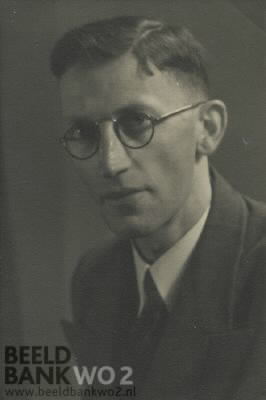 Newspaper ‘Trouw’ employee Pastor Henk de Jong was arrested at the same time as Walraven van Hall by the occupier. He was executed on February 12, 1945 in Haarlem. Source: Beeldbank WO2.
Newspaper ‘Trouw’ employee Pastor Henk de Jong was arrested at the same time as Walraven van Hall by the occupier. He was executed on February 12, 1945 in Haarlem. Source: Beeldbank WO2.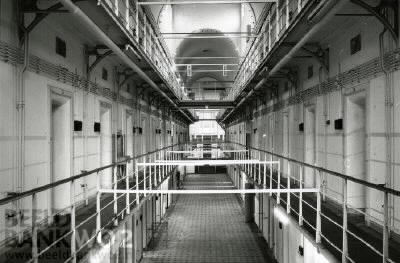 Interior of the ‘Huis van Bewaring’ (prison) on Weteringschans in Amsterdam where Walraven van Hall was imprisoned. Source: Beeldbank WO2.
Interior of the ‘Huis van Bewaring’ (prison) on Weteringschans in Amsterdam where Walraven van Hall was imprisoned. Source: Beeldbank WO2.After his death
The last months of the war
In spite of the death of Walraven the NSF continued its activities. The bank employee Peter Plantenga took over the tasks of Walraven van Hall. Because so many resistance workers were arrested in January 1945, the leadership of the illegality understood that it had to be a matter of betrayal. Soon they ended up with Van Lom. On March 5, he was shot by a KP-man.
Owing tot he good administration kept by the NSF, it is clear to define how much the organisation has spent during the war years. Based on the accident insurance claims forms and other receipts of the NSF, it is estimated that the institution was in charge of supporting 150.000 persons during the last year of the war. The National Support Fund has spent a total of DFL 83.765.786,69 for supporting (relatives) of people in hiding, seamen, railway strikers and resistance organizations during the occupation of The Netherlands. After the end of the war, another 22,5 million was in cash. With this money the activities of the NSF were continued for a while after the liberation. The persons who were supported were often unable to pick up their lives immediately after the liberation. The NSF also donated money to the establishment of the National Institute of War Documentation. Eventually the National Support Fund Foundation would exist until 1953.
Finally
Walraven van Hall was reburied after the war on the Eere begraafplaats (honorary cemetery) Bloemendaal at Overveen. In May 1946, he was posthumously awarded with the ‘Verzetskruis’ (Resistance cross) 1940-1945. For his great achievements of the Dutch resistance, Walraven van Hall received also various foreign awards, among others the Medal of Freedom with Gold Palm (united States) and the Yad Vashem-award (Israël).
The first post-war prime-minister of The Netherlands, Willem Schermerhorn, called Walraven van Hall the "absolutely central and leading figure of the resistance". Yet, Walraven van Hall received little attention in the years after the war. This had various causes. To begin with, Walraven van Hall grew up in an environment where it was not customary to brag about acts of their own circle. The Dutch Central Bank also shunned publicity about the fact that during the war, she fell victim to a huge fraud. So, it could happen that one of the greatest of Dutch resistance hero’s did not receive the credit he deserved.
This changed during the 1990s, when historian Geert Mak praised Van Hall in his book (see sources). On September 3, 2010 a monument was unveiled in honour of Walraven van Hall on the Frederikplein in Amsterdam. It is situated opposite the Dutch Central Bank, the place where the largest bank fraud ever in Dutch history took place. Loe de Jong wrote in his standard work on the Kingdom of the Netherlands in the Second World War, that the Dutch illegality may have lacked everything, but thanks to the work of the NSF, certainly not financial means. The National Support Fund was a unique organization in occupied Europe and Walraven van Hall was in fact the overall leader who led the organization.
Definitielijst
- resistance
- Resistance against the enemy. Often also with armed resources.
- Yad Vashem
- Yad Vashem is Israel’s national Holocaust memorial where in addition to Jewish victims and resistance heroes, also non-Jewish helpers of Jews during the World War 2 are being honoured. Those non-Jewish are called the Righteous Among The Nations. Until the mid 90’s trees were planted for these rescuers. In 1996 a special remembrance garden was established displaying all of the names of the helpers. Every year new names are added.
Images
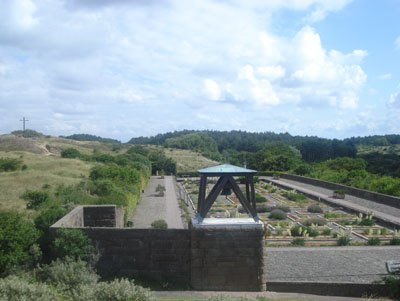 Dutch honorary cemetery Bloemendaal in Overveen, where Walraven van Hall is buried. Source: Oorlogsmusea.nl.
Dutch honorary cemetery Bloemendaal in Overveen, where Walraven van Hall is buried. Source: Oorlogsmusea.nl.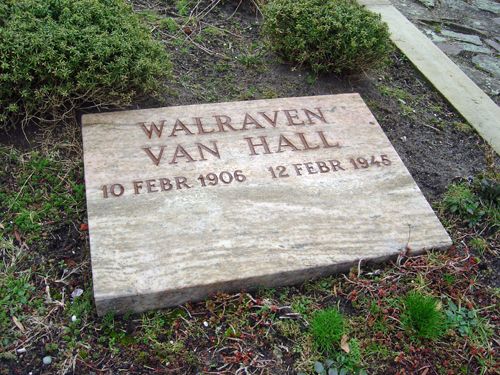 Tomb of Walraven van Hall on Bloemendaal cemetery. Source: Bekende Dode Nederlanders.
Tomb of Walraven van Hall on Bloemendaal cemetery. Source: Bekende Dode Nederlanders.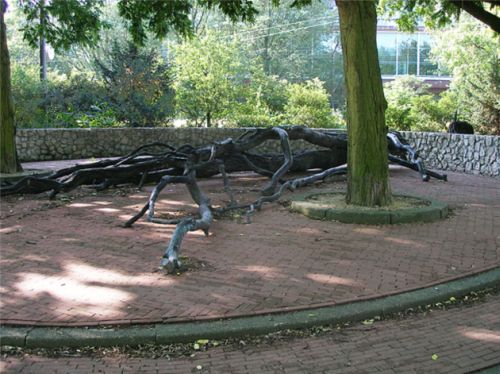 Walraven van Hall monument in Amsterdam, Frederiksplein. Source: Lida de Goede.
Walraven van Hall monument in Amsterdam, Frederiksplein. Source: Lida de Goede.Information
- Article by:
- Wesley Dankers
- Translated by:
- Cor Korpel
- Published on:
- 19-01-2025
- Feedback?
- Send it!
- 12-'39: I Was There! - The Fuehrer Had Just Left Us When...
- 04-'40: New Zealand Welcomes 'Achilles' Home
- 11-'40: I Was There! - I Lived Under Nazi Rule in Jersey
- 08-'42: Our Daily Round in War-torn Malta
- 02-'46: Now It Can Be Told! - D-Day Rehearsal at Cambridge University
- 04-'46: Our War Leaders in Peacetime - Field Marshal Alexander
- 05-'46: Our War Leaders in Peacetime - Attlee
- 12-'46: The Daring Raid on Rommel's H.Q.
The War Illustrated
Related sights
Related books
Sources
- MAK, G., Een kleine geschiedenis van Amsterdam, Atlas, Amsterdam, 1994.
- SCHAAP, E., Walraven van Hall, Stichting Uitgeverij Noord-Holland, Wormerveer, 2006.
- Groeneveld, E.G., 'Hall, Walraven van (1906-1945), Biografisch Woordenboek van Nederland, op: www.historici.nl
- Schaap, E., Bankier van het verzet. Een monument voor Walraven van Hall, Ons Amsterdam nummer 9, september 2010, op: www.onsamsterdam.nl
- Schaap, E., De arrestatie van Jaap Buijs, De Zaanstreek in de Tweede Wereldoorlog, 14 januari 2008, op: zaanstreek4045.wordpress.com
- Welgraven, C., Walraven van Hall (1906-1945). Bankier van het verzet, Historisch Nieuwsblad, nr. 8, 2010, op: www.historischnieuwsblad.nl
- en.wikipedia.org/wiki/Walraven_van_Hall

